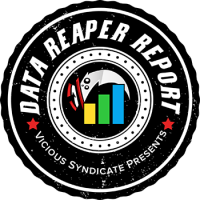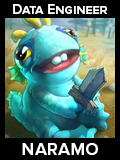
Welcome to the 126th edition of the Data Reaper Report! This is the first report for Rise of Shadows.
Our Data Reaper Project, including the Data Reaper Live has 4,400 active contributors and we thank them wholeheartedly. Contributing to the Data Reaper project through Track-o-Bot or Hearthstone Deck Tracker (recommended) allows us to perform our analyses and to issue the weekly reports. Without the community’s contribution, there would be no project. Contributing data is very easy and takes a few simple steps, after which no other action is required. If you enjoy our content and would like to make sure it remains consistent and free – Sign Up!
Quick Links
Class/Archetype Distribution | Class Frequency | Matchup Winrates | vS Power Rankings | vS Meta Score | Class Analysis & Decklists | Meta Breaker of the Week | How to Contribute | Credits
Number of Games
| Overall | 100,000 |
| Legend | 8,000 |
| Ranks 1-4 | 30,000 |
| Ranks 5-9 | 40,000 |
| Ranks 10-14 | 15,000 |
Class/Archetype Distribution
[TABS_PRO id=19782]
Class Frequency
[TABS_PRO id=19783]
Class Frequency Discussion
Watch your back. There are a lot of Rogues out there. Rise of Shadows’ first week seems to be true to lore, as Valeera has risen from the shadows to dominate the meta. Lackey Rogue is the name we have settled on to describe the current incarnation of Myracle Rogue, which is nearing 30% of the field at legend. It has many different builds and approaches, and most of its unique cards have not established themselves as true staples of the deck (including Myra’s Unstable Element), but there’s one clear exception: EVIL Miscreant. This minion is so powerful that it has truly shaped Rogue decks going forward, no matter which build path they end up taking. One of the key reasons for the archetype’s success is its ability to abuse Lackeys, so we believe the name fits better than “Tempo Rogue”, which meant a completely different deck just a few weeks ago.
Bomb Warrior was another deck that blew up on the first couple of days of the expansion, but there are signs pointing towards this archetype not being as dominant as it was initially perceived. At higher ranks, its representation gradually declines. Meanwhile, Control Warrior that does not utilize the bomb package is currently rising in popularity and overtakes Bomb Warrior at legend. We can also see some Dragon Warriors, which employ a similar game plan to Control Warrior. Regardless of the archetype, Warrior seems to be a very popular and successful class at all levels of play. Death Knights retiring from the format were a huge deal, leaving the Mad Genius free to rule as the late-game king.
My Greetings, Druids. Malfurion seems to have shaken off the loss of its absurd Year of the Mammoth sets and has taken the 3rd spot in popularity thanks to Token Druid, which is the 2nd most popular deck in the game at higher levels of play. Other Druid archetypes have yet to materialize into serious contenders.
Hunter is amid a transition. Initially, Mech Hunter decks were highly focused on a slower game plan involving Mechanical Whelps and Nine Lives. Very recently, a new brand of aggressive Bomb Mech Hunters came to prominence, and we will likely split these archetypes by next week. Midrange Hunters (with some of them now utilizing Zul’jin) are also around, followed by the Jepetto Malygos Hunters.
Mage is also still deep in a refinement stage, with most of the attention given to Conjurer’s Calling. Initially, it was utilized in a Control Mage deck that ran defensive AOE spells. This archetype is in the process of fading away, making room for a more dedicated Conjurer Mage deck that runs a build dense with minions, including a dragon package, Mountain Giants and Book of Specters.
With the crippling loss of its powerful late game, Warlock is now mostly an aggressive class, with Zoo Warlock establishing itself as the class’ most popular strategy. The archetype is centered on Magic Carpet builds rather than demons or imps. Handlock is currently a more modest presence.
Shaman is trying many different things with the powerful cards it has received this expansion. Murloc Shaman is the most prevalent archetype, with most builds going for a full tribal approach. Control Shamans vary between extremely passive builds, and slightly more proactive decks running Thunderhead. Finally, Morpher Shaman (sometimes called “Big”, but some of its builds don’t fit that description) is split between a “Big Priest” approach of cheating out high-value minions early with Muckmorpher and Eureka, and a Malygos approach utilizing burst damage.
Secret Paladin has failed to live up to expectations and quickly faded away after the first few days of the expansion. However, Mech Paladins utilizing the early game secret package are currently rising in popularity, so Paladins’ current share of the field could be underselling its standing in the meta.
Poor Priest has hit rock bottom, once again looking like a victim of its terrible classic set. The only fleshed out archetypes we currently find within the class are Silence Priest and the watered down, post rotation version of Wall Priest. We’re not giving up on Anduin’s chances of seeing some competitive ladder play, but it doesn’t look good right now.
[TABS_PRO id=19784]

[TABS_PRO id=19785]
vS Meta Score
[TABS_PRO id=19786]
vS Power Rankings Discussion
Lackey Rogue… kinda looks broken. The archetype is nearly 30% of the field at legend, and every single deck in the meta is trying to target it. Some decks even run two Oozes and Harrison Jones just to beat Rogues, and it’s not really working. Lackey Rogue displays a 54% win rate despite every attempt to beat it. Its worst matchup on ladder doesn’t break 40%, and only one class (Warrior) seems equipped to beat it consistently. We will say that other archetypes are far less refined and the meta is still very young, but Lackey Rogue has also not finished its refinement phase either, and we believe it can potentially perform even better once it’s fully figured out. The upcoming week will be the true test on whether anyone can stop Valeera.
Warrior seems to be the best antidote to Rogue, and its decks display win rates that perfectly match up to their frequency patterns. Bomb Warrior is stronger at lower skill levels but declines as you climb the ranks. Control Warrior gets stronger at higher levels of play and overtakes Bomb Warrior once you hit rank 4. It performs better in aggressive matchups and is the “hardest” counter to Lackey Rogue, which means a lot once you hit legend. It is probably the reason Control Warrior seems so prevalent the higher you climb at legend.
With that being said, we don’t think Bomb Warrior is completely redundant. It performs better in some matchups, specifically against decks that look to counter Warrior, where the inevitability of the bomb package can help Warrior seal the game before it’s overwhelmed, but it’s very likely that Bomb Warrior will continue to decline as Control Warrior grows in popularity. Another thing to keep a note of is discrepancy of skill. We haven’t 100% confirmed it yet since it’s still early, but Control Warrior’s performance at higher levels of play hints at a very high skill cap compared to Bomb Warrior.
The core Warrior shell seems strong enough to house whatever packages it wants to hold, and that includes Dragon Warrior, which isn’t very prevalent compared to the other two Warrior decks but is also very strong and cannot be underestimated.
The other very powerful and consistent ladder deck is Token Druid. Much like Lackey Rogue, this archetype’s matchup spread is quite absurd and there are very few counters available, with Zoo Warlock being the most notable one. Token Druid’s ability to challenge most early game board-centric decks, while still carrying enough threats and inevitability to give Warrior fits, is incredible.
Tier 2 at legend has a few decks that represent very hard counters to Warrior. This is probably why Warrior’s win rate is lower than Rogue’s and Druid’s. It’s very easy to build a deck that can lock Warrior out of the game, but it’s very difficult to build a ladder deck that dominates the other two.
We start with Conjurer Mage, which is the biggest hope for the Mage class at this current time. Conjurer Mage demolishes Warrior with ease but has a serious problem facing decks that are faster to get on board. It doesn’t have any strong AOE, so any swarming deck will be able to dominate the matchup. It will be interesting to see how it continues to refine because we do believe it may be able to equip tools that help alleviate this weakness.
Mech Paladin might be a more promising Warrior counter, because it also performs well against board flooding aggressive decks thanks to Consecration and powerful taunts, putting it at Tier 1 anywhere but legend. The problem is Lackey Rogue, which is a very painful matchup, especially if the Rogue runs Sap. The overbearing presence of Lackey Rogue is what knocks down Mech Paladin to Tier 2 at higher levels of play.
Mech Hunter is the archetype that is currently changing the most, which makes accurately capturing its performance a more difficult affair. The slower Nine Lives builds demolish Warrior but are absolutely crippled by terrible matchups against Rogues and Druids. However, the newer and more aggressive Bomb Mech Hunters perform better in these difficult matchups. Should they rise in popularity further, we could see a Hunter deck flirting with Tier 1. We should know more of their fate next week.
Zoo Warlock might be the fastest deck in the game thanks to its Magic Carpet build. This one card is such a handful for so many decks to deal with. Zoo Warlock’s future success, however, is uncertain. Contrary to what might be commonly perceived, Zoo Warlock doesn’t beat Lackey Rogue. Rogue has become a monstrous class that is no longer pushed around by aggressive decks thanks to the tempo swings that are generated by lackeys, its classic kit, its weapon removal and 0 mana Dread Corsairs. Zoo Warlock also falls miserably to Warrior, with only Rafaam offering hope in this matchup. To conclude, its performance might be a product of beating slow and unrefined decks in a new meta, and if things get ruthless, its win rate could end up tumbling down.
When looking at the bottom half of the table, there is some potential hidden within unrefined archetypes that may perform better once they’re figured out. We’ll highlight a few:
Murloc Shaman shouldn’t run a full tribal build. That experiment is failing to live up to whatever expectations it had. Murloc Shaman, however, is a strong deck when it sprinkles the good murlocs on a foundation of good Shaman cards. We estimate that Murloc Shaman has Tier 2 potential, at least.
Midrange Hunter should run Zul’jin, as it needs the late game power turn enabled by the troll to make up for the loss of Deathstalker Rexxar. Without Zul’jin, the archetype looks quite weak. With it, we’re interested.
Morpher Shaman must go the Big Priest route, as the Malygos version is horrid and cannot reliably close games. We think this archetype is relatively unexplored and has potential to be a decent deck, better than its current Tier 4 status would suggest.
Silence Priest looks unplayable yet becomes playable once it starts running Divine Spirit and Inner Fire. Once it can close games, even without the consistency of Shadow Visions, it looks like a real deck. A mediocre one, perhaps, but not a dumpster one.
Wall Priest is the most promising archetype for Priest because it’s even less refined than Silence Priest. It’s unlikely that a powerful deck is born from the class during this expansion, but there are signs that suggest Priest may not just be effectively deleted from the game.
We don’t have much hope for the rest of the decks listed at Tier 4 since they look genuinely bad. We’re surprised with how underwhelming Control Shaman has been. Miracle Mage flopped. Secret Paladin is likely stronger as a package to support Mech Paladin. Handlock looks awful. Academic Espionage still sucks. We also cannot find a secret meta-breaking deck at low sample sizes. The meta seems less diverse than it normally is at a beginning of an expansion. Valeera’s taking no prisoners.
Class Analysis & Decklists
Druid | Hunter | Mage | Paladin | Priest | Rogue | Shaman | Warlock | Warrior
Rogue has met our expectations, establishing itself as the most dominant class on the first week of Rise of Shadows. Lackey Rogue, the new incarnation of Myracle Rogue, is the most popular and most powerful archetype in the game. It is a fitting name considering that EVIL Miscreant has become an absolute powerhouse of a card, and Rogue’s abuse of Lackeys drives its success in the current meta.
There are two main variants of Lackey Rogue, and we’ve done a lot of research to come up with the best possible builds for these two approaches. We consider both variants very powerful, and either of them will likely produce success on ladder.
The first approach is, in Twitch language, the SMOrc version. It is currently the best performing variant. It is very similar to Rastakhan Myracle Rogue and is quite straight forward in its approach to games. Waggle Pick can produce a lot of damage and is a terrific fit with Raiding Party, Dread Corsair, Captain Greenskin, and Leeroy Jenkins. EVIL Miscreant is the only other new addition and is one of the best cards in the deck. We also have three standout insights that shaped our featured build, which is a bit different from what you commonly see on ladder.
- Hench-Clan Thug has proven to be underwhelming in most matchups. It performs terribly in the mirror since it is far too easy to remove (Waggle Pick, Eviscerate, Sap, Vendetta), and is only a reasonably powerful card when it’s played specifically on turn 3, and only when going first. We would always rather have EVIL Miscreant, Preparation and Raiding Party in our opening hand, which is why we’ve reduced Thug to a single copy. It would be completely omitted if Rogue had better options on turn 3, and there’s a possibility it will eventually find them.
- Zilliax is being grossly underplayed and underrated in Rogue builds. It is very strong in the mirror since it almost always trades 2 for 1 and allows you to swing back health in a matchup that often becomes a race for damage. It can completely disrupt your opponent’s game plan and buy you enough time to seal your own race for lethal.
- Fan of Knives is a sleeper. The card was a staple for this shell during Rastakhan (due to Odd Paladins), and after extensively researching to fill those elusive final slots, we’ve found it to be performing extremely well. It is specifically amazing against Druids, and we suspect this matchup will become very relevant going forward. Since it replaces itself, it’s also not a complete liability in slower matchups.
The second approach is the OpieOP version. It incorporates the “Burger” package with Hench-Clan Burglar, Blink Fox, Vendetta and Underbelly Fence. These cards provide great tempo swings in the mid-game that make this variant surprisingly effective in the mirror, despite being greedier. With the addition of Togwaggle, this deck can also last longer and consistently pressure opponents in slower matchups. This variant currently looks inferior to the SMOrc version, but we suspect it might be a result of a larger number of underperforming cards included in its builds. In simple terms, this deck is not as refined, and we would like to refine it before reaching a verdict on whether it’s strictly inferior. Our insights:
- There’s a view that Heistbaron Togwaggle and Myra’s Unstable Element do not belong in the same deck. We disagree with this view. MUE is admittedly weaker in this list since you tend to generate more resources in hand, but the fact it’s not “absurdly broken” doesn’t mean the card should be cut. It is still a game-changing effect that is consistently stronger than popular alternatives we’ve seen being tested. In addition, while Togwaggle and MUE don’t work too well together, we run both so that we draw one of them by turn 7 and gear our game plan accordingly. This significantly improves the otherwise difficult Warrior matchup and doesn’t punish us in the mirror as much as it’s perceived. As noted earlier, this variant’s swing tools in the mid-game make it quite decent in the mirror.
- Togwaggle is much stronger in the presence of Cable Rats and we suspect that Heistbaron has been unfairly deemed underwhelming by some players as a result. We think that Rats are simply core in a list that runs Togwaggle, since they allow you to use Lackeys more optimally and freely. Cable Rat is not a bad card by itself either: it is a decent turn 3 play and a flexible card later in the game. If you’re running SI:7 Agents over Rats in a Togwaggle list, the switch looks like a no-brainer.
- Shadowstep is extremely overrated. It just sucks, has proven to be a crippling win rate sink for Lackey Rogue, and there isn’t a single matchup where it doesn’t perform poorly. Shadowstep is nice when it’s attached to a 4-attack weapon, less so when we must invest a card for its effect. Far too situational.
- Ooze is a tempting tech card but isn’t worth it, even when considering the prevalence of the mirror. It’s strong against Waggle Pick, and that’s about it. Nuking a Supercollider won’t even beat Warrior. It’s all about having enough threats and damage, so a Bloodfen Raptor doesn’t cut it. It’s a tournament tech card.
Other Rogue archetypes haven’t taken off. Thief Rogue still looks very weak. Vendetta and Underbelly Fence have found a better home as part of a smaller thief package in Lackey Rogue. If you are interested in playing Thief Rogue, forget about Academic Espionage and run Raiding Party. We’re featuring a list that’s likely the best one Thief Rogue has to offer, because it runs EVIL Miscreant.

Warrior is back in a big way in Rise of Shadows. Three expansions’ worth of excellent cards in otherwise underwhelming Raven sets finally bear fruit after the disappearance of Death Knights as well as several OTK mechanics. With one of the only hero cards left in the format, Warrior’s late game has become one of the most dominant available.
Rogue is probably a stronger class overall, especially for ladder, but Warrior is here to stay as a top-level class and one that’s capable of challenging Valeera. The Warrior class is currently exhibiting several different strategies, but they all rely on a shared core that has proven to be very strong and well-rounded.
The day 1 sensation is Bomb Warrior, an archetype that relies on a package of cards given to the class in Rise of Shadows. The bomb package provides inevitability in attrition matchups, pressuring your opponent’s life total as he continues to draw his deck. It also enables Blastmaster Boom, which is an extremely powerful turn 7 play that is often game ending. If Dr. Boom was powerful, then Blastmaster Boom is straight up nuts.
There are two schools of thought regarding Bomb Warrior. The first goes all-in with the Bomb package, running cards like Seaforium Bomber, Captain Greenskin and Upgrade. This approach goes a bit too far, as these cards are costly to include due to their standalone weaknesses. The second approach embraces a Control Warrior build, with the good Control Warrior stuff, and sprinkles the serviceable bomb cards. This variant looks stronger and more consistent. Elysiana is included so that we don’t just automatically lose Warrior mirrors. It’s pretty awful in other matchups but the number of Warriors is currently high enough to charge the “protection” money.
Control Warrior cuts the bombs in order to run more of the “good stuff”. It performs better in aggressive matchups, where the bomb package is weak, instead relying on Elysiana to win fatigue in slower matchups.
When we evaluated Warrior in general, we’ve gathered several insights that led us to our featured Elysiana Fatigue build.
- The Rush package looks core. Town Crier, Militia Commander, and Zilliax should be in every Warrior deck that can afford them, and Darius Crowley is excellent too if the deck has enough space for it.
- Omega Devastators perform extremely well. Execute requires too much of a deck building investment to run and is too situational compared to Devastators that can help fight for the board early and synergize with Dr. Boom.
- Weapons’ Project is extremely flexible as an early removal, weapon destruction, and Shield Slam enabler. Fantastic with Harrison Jones.
- Acolyte of Pain is weak. We don’t have good activators for it (Blood Razor’s gone), and it can terribly backfire in the mirror with Hecklebots. Town Crier is a far better source of card draw. We want to draw cards mostly in faster matchups, and we want to draw rush minions in faster matchups. It’s a perfect fit for the deck.
- Hecklebot is an important card in the mirror. Elysiana is obviously crucial in the mirror and Baleful Banker or Youthful Brewmaster become a relevant choice in a heavy Warrior meta.
- Unseen Saboteur isn’t worth it and can sometimes backfire. There aren’t enough combo decks on ladder that can be effectively and consistently targeted by it, so we give it a pass.
Warrior’s success doesn’t just end with these two lists. The Control Warrior shell seems capable of housing alternative packages that are also quite successful.
Mecha’thun Warrior is a small sub-archetype that’s meant to dominate mirrors with an OTK instead of entering an arms race of who can play Elysiana more times. Unlike other Warrior decks, this deck has a combo win condition, so maxing cycle pays off. DeadDraw took this archetype to #1 legend.
Dragon Warrior is also promising. Much like Bomb Warrior, its initial experiments involved a heavier package of dragons, and the deck improved once it dropped forced tribal synergies to include more of the good stuff Control Warrior usually plays. This deck can generate the most resources out of any Warrior deck (ignoring the degenerate Banker/Elysiana arms race).
To conclude, it seems like no matter what package you throw into Control Warrior; you’re generally going to have a good time. Identify the strong core and you can almost do no wrong.
Druid looks very good thanks to the success of Token Druid, and the class is firmly established in the top 3 alongside Warrior and Rogue. Token Druid’s matchup spread is incredible, and it goes toe-to-toe with the other best decks in the new meta. If you’re interested in a non-polarizing deck that can beat anything it faces, there is probably no better choice. For ladder, Token Druid could well be the most consistent deck in the game.
The key to Token Druid’s ability to match up well enough against any opponent lies in two key cards. Wispering Woods is almost impossible to deal with on turn 4 for any deck that doesn’t carry AOE. This makes Token Druid extremely difficult to consistently push off the board in the early game. Meanwhile, The Forest’s Aid provides the deck with incredible reload potential, constantly pressuring slower opponents for answers. The Forest’s Aid is the main reason why this deck can be a handful for Warrior to deal with.
When evaluating Token Druid builds, we’ve found that the list we’ve theory-crafted before the expansion’s launch is the best one. Crystalsong Portal is not as powerful as we expected it to be, but it’s very relevant in any late-game matchup, while also providing fuel for more consistent early Wisp gambits. We haven’t seen a card that compelled us to deviate from these 30. Other 1-drops such as Argent Squire, Mecharoo and Crystallizer are underwhelming minions that we don’t even want to keep in the mulligan because Acornbearer, Wispering Woods and Dreamway Guardians are far more important to find. Eccentric Scribe, Force of Nature, Mulchmuncher and Dendrologist are also weak. Microtech Controller might be the strongest unincluded card that we ran into.
The unfortunate part of Druid’s venture into Rise of Shadows is the failure of every other archetype besides Token Druid. Malygos Druid has completely disappeared, and while Heal Druid has some strong cards, the game plan itself is far too weak to be worth the trouble. A completely new discovery needs to happen to change Druid’s current standing of a 1-deck class.
After failing to produce consistently good results with any deck in the first couple of days of the expansion, the Mage class was in danger of fading into irrelevance. Then, hope was found with Apxvoid’s Dragon Conjurer Mage, and this archetype has likely become the strongest one available to Jaina.
Conjurer’s Calling has been through several iterations since Rise of Shadows’ release. It was initially included in a Control Mage shell that ran AOE board clears and freezes, but those builds have proven to be terrible. The minion-heavy dragon build allows Mage to cash in on the powerful draw engine, Book of Specters. BoS works incredibly well alongside Mountain Giants and Twilight Drakes as our best early game openers, and we want to run Mountain Giants because of their powerful interaction with Conjurer’s Calling.
The dragon synergy cards aren’t just filler, they complement the minion-dense build with pseudo removal that helps us fight for the board and come back to it when we’ve fallen behind. Scaleworm, Dragonmaw Scorcher, Crowd Roaster, and Kalecgos all serve as potential board swing cards, while Firetree Witchdoctor can discover a useful spell for this purpose too. The deck plays out similarly to Spiteful decks by overwhelming the opponent with stats and taking advantage of Conjurer’s Calling to ramp up board pressure. As a result, Conjurer Mage crushes Warrior, since its threat density will usually exceed the Warrior’s capacity to remove.
Conjurer’s Mage is great in slow matchups, but has a major issue dealing with faster decks, so our build will be focused on alleviating this weakness.
- Based on its performance, Dragonmaw Scorcher is a core 2-of as it is essential to beat Druid and is also quite strong against Zoo. We want all the AOE we can get through minions, and it’s a dragon. For the same reason, one Mossy Horror appears to be a valuable tech.
- Rotten Applebaum and Safeguard don’t do much in faster matchups, since they’re very clunky and Rogue will usually have an efficient way to remove a single taunt. The best defensive combo against Rogue is to play Conjurer’s Calling with Sunfury Protector, developing two taunts on the same turn.
- Mind Control Tech and Messenger Raven both look bad. MCT just doesn’t do enough against the current decks that tend to flood the board, while Raven is usually a stop-gap 3-drop that doesn’t interfere with your Mountain Giants. We’d rather cut them altogether.
- Finally, Rabble Bouncer seems to be one of the most promising additions to the deck. It allows us to cheat out a defensive taunt early against board flooding decks and has great synergy with Conjurer’s Calling.
As we’ve hinted earlier, other Mage archetypes have mostly fallen flat. Low curve spell-centric Mage decks look like Tier 6 material. The only archetype other than Conjurer Mage that has an outside chance of being a real deck is Freeze Mage, which SoLegit has done well with.
Hunter has formed some decent decks since Rise of Shadows launched, with both Mech Hunter and Midrange Hunter becoming somewhat popular. Each archetype can take advantage of solid Warrior matchups. However, both archetypes struggle to deal with Rogues and Druids, which interferes with their prospects.
Midrange Hunter has plugged its rotation gaps with some serviceable cards. In its early curve, Shimmerfly offers a turn 1 play, Hench-Clan Hogsteed is a pretty good 2-drop and Dire Wolf Alpha fits the deck’s playstyle. When it comes to Midrange Hunter’s late game, the loss of Deathstalker Rexxar has encouraged usage of Zul’jin as a late game value bomb. Unleash the Beast has great synergy with Zul’jin while offering some comeback mechanics, and Dire Frenzy is also included for its synergy with Zul’jin. In the absence of the Death Knight, Dire Frenzy looks like a more reasonable choice than it was in the past and belongs in the deck through merit.
When it comes to Mech Hunter, there are two different builds and we’ve yet to separate them due to the late appearance of one of the builds. The first and early build focused on a small package of mechs centered on Mechanical Whelps and utilizing Nine Lives and Fireworks Tech to proc more threats. This list was complemented by a Zul’jin shell of spells but performed very poorly on ladder due to atrocious matchups against Rogues and Druids. It doesn’t seem to be worth the trouble now.
The relatively new build, which we’re featuring, has only begun to show up a few days ago and is a more aggressive Bomb Mech Hunter. This deck’s sole purpose is to vomit mechs, Goblin Bombs and magnetic buffs on curve while hitting the opponent in the face. Strangely, this thing works. Much like the Mechanical Whelp variant, it demolishes Warriors, but it doesn’t completely roll over and die to the other two powerhouse classes. Uberer hit #2 legend with a build we feel is very close to being optimized, cutting some of the more questionable card choices we’ve seen tested. Yes, Boommaster Flark’s playable!
Malygos Hunters were also popular at the start of the expansion; however, the deck looks to be slowly fading into irrelevance thanks to the pressure from Rogues and Druids. While Jepetto pulling out Alexstrasza, Malygos or Vereesa usually ends games a turn later, the Zul’jin removal shell supporting the deck doesn’t seem to be strong enough to allow this deck to survive faster matchups.
We expected that the best chance for Warlock’s viability after rotation was Zoo and so far, it is doing well. With AOE removal less prevalent, Zoo Warlock has hit the ground running… or perhaps, it’s flying on a carpet instead.
Magic Carpet is the card we underestimated the most. We didn’t expect it to single handedly carry a deck full of mediocre 1-drops into playability, and that’s what it’s basically doing. Scarab Egg and EVIL Genius also provide the list with enough synergy alongside Grim Rally and Sea Giants to become an intimidating board flooding threat. Perhaps, the second MVP of this deck is Rafaam, since it gives Zoo a chance to win late game matchups it would otherwise have no business of ever winning. When it comes to the list, there’s one obvious trap card we’ve identified: Saronite Taskmaster. It wasn’t good 4 months ago, and it isn’t good now.
Beyond the initial enthusiasm though, there are concerns regarding Zoo Warlock’s future. Contrary to popular perception, this deck doesn’t beat Rogues. It also miserably struggles against all forms of Warrior. It is the hardest counter in the game to Token Druid, due to the Druid’s inability to deal with Magic Carpet, but beyond this matchup, it doesn’t perform well enough against the very best decks. Its current win rate might be a product of a young, unrefined meta filled with decks that fall prey to a fast opponent. Should the meta become ruthless, Zoo Warlock’s performance could take a sharp nose dive.
And should Zoo Warlock fall back to earth, there isn’t much else to say regarding the class’ prospects. Handlock looks unplayable and Control Warlock decks would struggle to hit Tier 6. Gul’dan may only have one strong hand before the meta calls his bluff, and he’s only got one real archetype to save him.
Shaman has received many good cards, and they’ve sparked a lot of ideas. However, none of these ideas have resulted in a dominant deck so far, and none of the things Shaman currently does look as busted as what Rogue, Warrior and Druid are doing.
We’ll start things off with what is likely the best Shaman deck: Murloc Shaman. Most players have created full tribal decks, but these decks are significantly inferior to what we’ve suggested before the expansion: only playing the best murlocs the tribe has to offer. The featured Murloc Shaman that we’ve theory-crafted, utilizing a Thunderhead package and a Warmage package, is performing very well. Should it take over the archetype, it will likely increase Murloc Shaman’s win rate. It’s simply not worth it to run mediocre murlocs over good Shaman cards.
Morpher Shaman might also be slightly misrepresented in stats due to experimentation with Malygos builds. These builds are atrocious and the sooner they’re forgotten, the better. Morpher Shaman shines as a Big Priest type of deck, not as a burst deck, and we’ll have to see what steps are taken to refine it, because it has seen very few experiments relatively to other archetypes. Krea hit top 200 legend with a build that utilizes Likkim, which gears the deck to performs better against aggressive decks.
You’d think that with so many good late game cards, Shaman will be able to field a respectable control deck. The problem is that Warrior has a stronger attrition game plan that totally outclasses what Shaman can come up with, and Shaman doesn’t have the means to actively kill its opponents at a certain point. Control Shaman also gets hard countered by anything that hard counters Control Warrior, so it gets caught in the crossfire very often. For now, this archetype is dead.
Paladin’s story in Rise of Shadows so far is a mixed bag. Secret Paladin hasn’t turned out to be the dominant deck it could have certainly been with Divine Favor. Instead, the deck runs out of steam and fizzles out quickly, though we will say that Subject 9 helps a lot.
Though the archetype itself is underwhelming, the individual cards that Secret Paladin has received are very strong, which has encouraged players to look for a slower deck that can utilize them properly. This has led to the rise of Mech Paladin, with what we’ve tipped to be one of the strongest win conditions in the post-rotation meta: Kangor’s Endless Army.
So, players took Mech Paladin, slapped the early game secret package on top of it, and the result is a very promising archetype that utterly dominates Warrior while performing admirably well against Druids. Rogues are still a problem, especially when they run Saps, but two out of three isn’t bad.
When looking for ways to improve the common build of Mech Paladin, we’ve reached a very simple conclusion: This deck wins when it gets to magnetize a Whelp or an Egg into a taunt. This makes Annoy-o-Module and Zilliax crucial for winning any game against a fast-paced deck. So, we’ve looked to fill the final questionable slots with something that can replicate this effect, even to a lesser degree, and we’ve found Bronze Gatekeeper. After running into this card, we’ve scouted the data matrix and found a few smart cookies who already had this idea, and it was working well for them. Try it out.
As we’ve feared, Shadow Vision and Psychic Scream were just that good, and losing them has proven to be back-breaking for Anduin. We were foolishly optimistic about the cards that the Priest class has received in Rise of Shadows, but it doesn’t seem to be enough to pull it out from the bottom it has sunk into, not yet anyway.
With that being said, we don’t think Priest is hopeless, and there’s a chance it finds a competitive deck. Silence Priest has looked underwhelming so far, but there’s a key conclusion we’ve reached after evaluating its builds: It must run Divine Spirit and Inner Fire, even without Shadow Visions. Otherwise, Silence Priest just can’t close games. We’re featuring what is likely to be the best list, taking what we’ve found into consideration.
Another lead could be Wall Priest. Once again, we’ve found that the Inner Fire win condition is too important. While this deck is a lesser version of one which we saw during Rastakhan, it has the potential to become legitimately competitive. There’s no Oakheart anymore, but Catrina Muerte can do quite a bit of work in the late game alongside Mass Resurrection.
Lackey Rogue, Token Druid, and Control Warrior are the nuts. Lackey Rogue and Token Druid are very consistent across many different matchups and are just difficult to stop on ladder. Control Warrior has some hard counters, but it’s the only reliable answer to Lackey Rogue, and forces the Rogue to get greedier in order to improve the matchup. We think those are the three best decks in the game and the ones likely to find you success, especially at higher levels of play.
But if we had to pinpoint towards an underdog, it would probably be Mech Paladin. The Rogue matchup is the main factor that holds it back, and if it can find a way to increase percentages there without giving up too much elsewhere, it’s potentially a meta breaking deck.
We do identify several decks that could change the current landscape, so maybe it’s a bit too early to panic about Rogue?
Or maybe, Rogue really is just that damn good.
Our Data Reaper Project, including the Data Reaper Live has 4,400 active contributors. Without them, this project would not be possible, so we’d like to thank all of our contributors for their help.
Preparing our weekly article requires a significant amount of time and effort from many individuals. We would like to wholeheartedly thank our current Patreons, whose generous donations help us fund computing and server costs.
vS Gold is a new membership plan aimed to support our efforts towards improving our content and data analysis while receiving some bonuses and extra features.
Tier 3+ Patrons
Special thanks to Leo G, Aaron B, Jed M, Drew M, Alan J, Eric L, Zolstar, Sean H, Steve F, Andrew N, NObdy, Mark S, Alonso P, msKang, Andrew R, James Y, PinkMageDiaries, Je-ho, Adam P, Ziqiao Y, and Stephen H for supporting us for the month of April.
Contributors
Here are all the people that participated in bringing you this edition of the vS Data Reaper Report:































https://www.hearthpwn.com/decks/1266283-top-300-legend-otk-ress-priest
https://www.hearthpwn.com/decks/1266032-eureka
This is the Morpher deck I made for shaman. Went from rank 20 to 8 on nearly one winstreak. The deck is pretty flexible. It all depends on whether you draw your morphers and what you pull with them. Al’ Akir generally causes a face strategy. It is a deck that requires lots of games to feel out as although I was winning the earky rank games my understanding of the deck caused some poor play. Ysera for one big bad possibly but this list has worked great without it,
You need to find a new mage expert. Power of creation is average at best in the conjurer deck. Need to have a lower curve in an aggro meta. Particularly when the deck crushes Warrior anyway. This build that Alliestrasza took to legend performs much better.
AAECAf0EBPsGoIADlpoDip4DDYoH4QeNCM7vAonxArfxAsP4AtuJA+iJA+yJA+iUA+eVA4OWAwA=
I’ve been playing a lot of token druid, and I find Microbot Controller to be superior to EVIL Cable Rat, so I swapped out both. I also find Mark of the Loa underwhelming and replaced one copy with a Force of Nature.